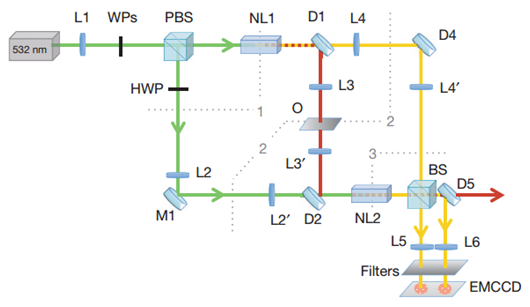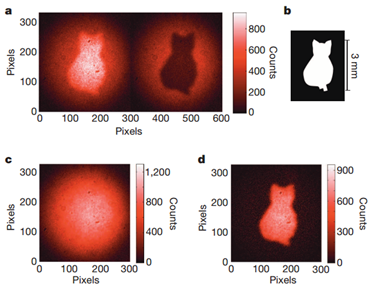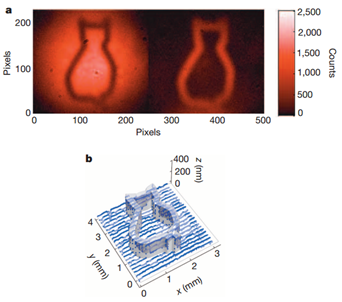一、本期重点:
1.通过未探测到的光子进行量子成像【Nature】
doi: 10.1038/nature13586
published:2014.8.27
内容介绍:
当量子叠加态存在不确定性时,量子相干效应才可能发生,而能够区分叠加态的信息时,就会抑制量子干涉。文章介绍并通过实验验证了一种基于诱导相干的量子成像方法。实验中使用了两个分离的下转换非线性晶体(标号NL1和NL2),每一个晶体都由同样的泵浦激光器照射以产生一对光子。从两个晶体中导出的信号的振幅干涉表示了物体的像。经过待成像物体的光子不可能被探测到,但是可以仅用来自NL1和NL2的不接触待成像物体的光子信号获得图像。文章中提出的实验方法与之前的量子成像技术如interaction-free imaging、 ghost imaging等存在实质性区别,因为这一方法中用来照明物体的光子完全不需要被探测,所以探测波长可以选在探测器无法检测的波段,实验中获得了对探测光子来说为透明或不可见的被测物的像。文中提到的实验可看作量子信息传输的原理性实验,通过不被探测到的光子来提取信息。
图1为实验装置示意图。532nm的激光器(绿色)为光源照明晶体NL1和NL2,波板(WPs)用来调整偏振分光镜(PBS)输出的相对相位和光强。分色镜D1将下转换的810nm(黄色)和1550nm(红色)分开。1550nm的光子被传输经过物体O并由D2分色镜传至NL2中。透镜将平面1成像到平面3,将平面2成像到EMCCD相机。分束镜(BS)的反射透过比为50:50,分色镜D1、D2、D4和D5传递泵浦。图2和图3分别为实验获得的强度像和相位像。

图1 量子成像实验原理图

图2 强度成像 a.将b中所示卡片放在D1与D2光路中时,BS的输出,在猫形轮廓外部,NL1中的光子被遮挡无法通过,因此不能形成干涉c.信号输出总和给出了信号的强度轮廓d.两次输出之差提高了干涉对比度

图3 对不透过810nm的物体所成的位相像 a.当被测物是一个刻蚀3mm高的猫形图案的硅板(对810nm不透明)时在BS的输出端对810nm光子进行探测所得图像 b.刻蚀板的三维渲染图
2.相干照明工程及定量相位成像【Optics Letters】
doi:10.1364/OL.39.005634
published:2014.9.24
内容介绍:
部分相干照明有很多优点,如无散斑成像、在光学显微镜中提高光学切片的性质等。在对活体细胞、微米尺寸粒子等物体的定量相位成像(QPI)时,对照明的时间和空间相干性的要求十分严格。文章提出了一种相干照明工程的新颖技术,该技术基于一个DMD投影机来产生实现可控的多波长和空间相干设计,实验验证了不同空间相干状态下QPI的成像情况。
实验中,样品的明场聚焦和离焦图像由彩色相机获取用于监测和定量分析如图1。对于QPI,使用图4(a)的含有一个快速电可调镜头、大数值口径的物镜和高分辨率sCMOS相机的装置测量若干幅离焦像,图4(b)为浸在纯水中聚苯乙烯球散射的光的衍射图样。实验结果证明利用基于离焦的迭代相位重建技术,即使部分相干照明也可以实现QPI。

图4 (a)相干照明装置(b)测得的样品明场图像,三种对焦距离、六种不同的相干状态
二、简讯:
doi:10.1364/OE.22.024276
published:2014.9.25
Abstract:
We report the fabrication and characterization of freestanding grapheme coated ZnO nanowires (GZNs) for optical waveguiding. The GZNs arefabricated using a tape-assist transfer under micromanipulation.Owing to the deep-subwavelength diameter and high index contrast of theZnO nanowire waveguide, light-graphene interaction is significantlyenhanced by the strong surface optical fields, resulting in a linear absorptionas high as 0.11 dB/µm in a 606-nm-diameter GZN at 1550-nm wavelength.Launched by 1550-nm-wavelength femto-second pulses, a 475-nm-diameterGZN with a graphene coating length of merely 24 µm exhibits evidentnonlinear saturable absorption with a peak power threshold down to 1.3 W.In addition, we also demonstrate a transmission modulation for 1550-nm-wavelength signal with a 590-nm-diameter GZN, showing the possibility of using GZN waveguides as nanoscalebulding blocks for nanophotonicdevices.
doi:10.1364/OE.22.024224
published:2014.9.25
Abstract:
A simple beam-scanning optical design based on Lissajous trajectory imaging is described for achieving up to kHz frame-rate optical imaging on multiple simultaneous data acquisition channels. In brief, two fast-scan resonant mirrors direct the optical beam on a circuitous trajectory through the field of view, with the trajectory repeat-time given by the least common multiplier of the mirror periods. Dicing the raw time-domain data into sub-trajectories combined with model-based image reconstruction (MBIR) 3D in-painting algorithms allows for effective frame-rates much higher than the repeat time of the Lissajous trajectory. Since sub-trajectory and full-trajectory imaging are simply different methods of analyzing the same data, both high-frame rate images with relatively low resolution and low frame rate images with high resolution are simultaneously acquired. The optical hardware required to perform Lissajous imaging represents only a minor modification to established beam-scanning hardware, combined with additional control and data acquisition electronics. Preliminary studies based on laser transmittance imaging and polarization-dependent second harmonic generation microscopy support the viability of the approach both for detection of subtle changes in large signals and for trace-light detection of transient fluctuations.
doi:10.1364/OL.39.004687
published:2014.8.6
Abstract:
We present and demonstrate a technique called RED-SEA TADPOLE for the spatio-temporal characterization of highpeak power femtosecond lasers. It retains the basic principle of an existing method, where a scanning monomodefiber is utilized in an interferometric scheme to measure the spectral amplitude and phase at all points across anultrashort laser beam. We combine this approach with dual spectral-band interferometry, to correct for all phaseerrors occurring in this interferometer, thus allowing for the simultaneous measurement of the beam wavefront andpulse front in a collimated beam of large diameter. The generic phase correction procedure implemented here canalso be extended to other fiber optic device applications sensitive to phase fluctuations.
供稿:师途







